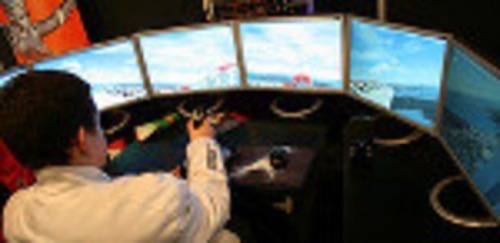
What kind of friend would you be if you kept the powers of virtualization all to yourself? Something this good needs to be shared, but if your friends are non-technical, you have to get over the hurdle of explaining it to them.
Try this: “It’s a computer simulator.” In the same way a flight simulator provides a pretend jumbo jet to play with, virtualization software provides a simulated computer to use. And like with a physical plane, there are many things you can do with virtual machines (VMs) that physical ones cannot do.
Here are four cool tricks you can use to explain virtualization:
Save Game
Anyone who has played Elite, Monkey Island, Tomb Raider or Sim City understands the need for “save game” – that’s everyone right?
The virtualization name for this is “snapshot”. Snapshots allow you to pause your PC in the middle of what it’s doing, and save the current state – disk, memory, windows, clipboard, everything – to disk. You can come back at a later date and carry on where you left off; or you can rollback to a previous saved game – the one where you hadn’t opened that dodgy email attachment.
If you have a theory you want to test, try it in the virtual machine. If it does not work out you’ll lose nothing. Rollback and try again. When was the last time you took your PC for a joy ride and drive it off a cliff?
Portability
That funny little pocket in your Levis is designed to hold a USB flash drive that contains a virtual machine. Fact.
Now you can travel light, and run your Windows 3.1.1 virtual machine on your buddy’s Mac when you get there – no problem! It is quite reasonable to fit two or three virtual machines on a $20 flash drive. This means you can carry your virtual machines, set up with all your favourite apps with you, where ever you go. No excuses.
Legacy Applications
Did someone say Windows 3.1.1?
Many organisations have legacy applications that can only run on a certain version of the operating system, or cannot co-exist on the same system with other applications. These troublesome applications can often be the reason why some antiqued computer with untouchable status exists in a dusty corner of an office.
These applications can be set up in their own virtualized container – one VM for the sole purpose of running this application. Like Lieutenant Worf trapped in the Holodeck, the legacy application is unaware it is being duped by the simulated environment.
Server Consolidation
This is carpooling, but for virtual machines on physical servers.
Server consolidation is most relevant to organisations that run lots of applications deployed across multiple servers. When a virtual machine provides a network service (like webmail) instead of a desktop-based application (like Minesweeper), then the monitor, keyboard and mouse becomes less important. These kinds of virtual machines – servers – can share a host machine, and can be moved to a different host machine without anyone noticing.
Running many virtualized servers on a single physical server allows for greater utilization of resources. Sophisticated virtualization tools allow resources (processor power, RAM, disk space) to be reallocated where and when it is needed. Low-priority servers can be suspended or run at reduced speed. Applications which only need to run at certain times of the month, or require extra horsepower at peak times. Higher utilization translates into fewer servers, which means less money and reduced running costs (electricity, CO2, data center space, cooling, etc.)
So now you know how to equip your friends with the super-powers of virtualization, what do you think they’ll do with them?
Image credit: wlodi










